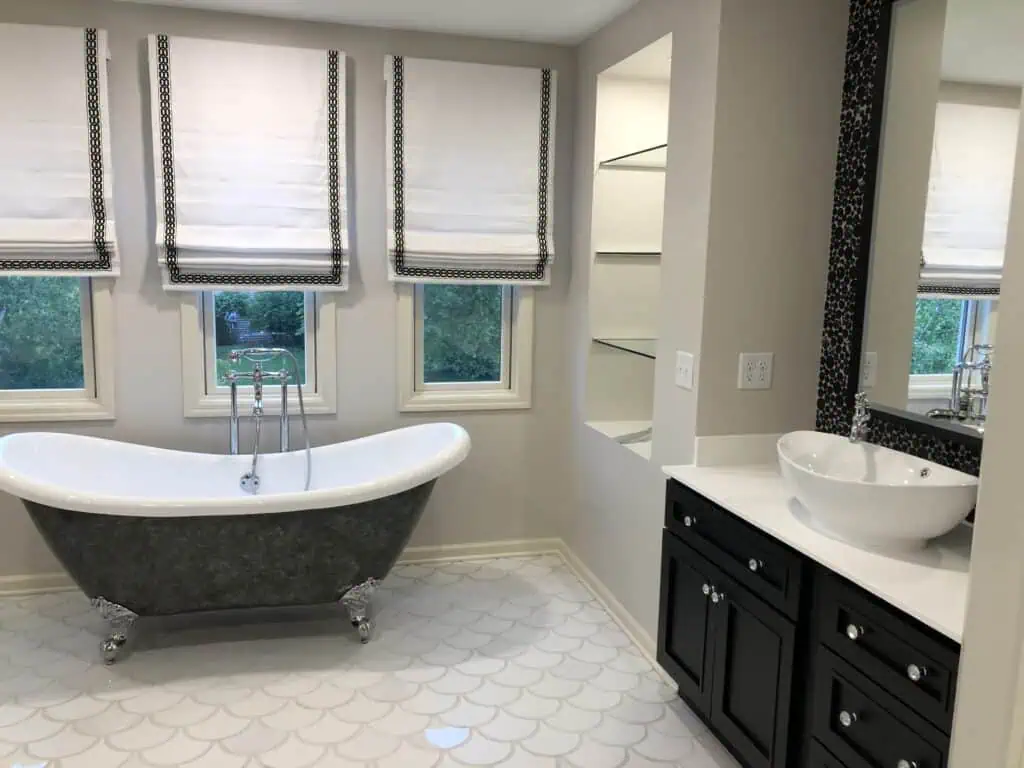Transforming Your Personal Oasis: The Power of Bathroom Reconfiguration
Imagine stepping into a bathroom that not only meets your needs but exceeds your expectations – a space that’s both functional and beautiful, where every inch is thoughtfully designed to enhance your daily routine. This dream can become a reality through the art of bathroom reconfiguration. Whether you’re dealing with a cramped powder room or a master bath that’s lost its luster, reimagining your space can dramatically improve your home’s comfort and value.
According to a recent survey by the National Association of Home Builders, bathroom remodels are among the most popular home improvement projects, with 81% of homeowners citing better functionality and modernization as their primary motivations. Let’s explore how you can join this trend and create a bathroom that truly works for you.
The Benefits of a Well-Planned Bathroom Makeover
A carefully executed bathroom reconfiguration offers numerous advantages:
- Improved functionality: By rethinking the layout, you can create a more efficient flow and easier access to essential features. Imagine transforming a cramped shower area into a spacious walk-in shower with built-in seating – a change that can make your morning routine a joy rather than a chore.
- Increased storage: Smart design solutions can maximize storage capacity, reducing clutter and enhancing organization. Picture replacing a pedestal sink with a vanity that offers ample drawer space, instantly solving your storage woes.
- Enhanced aesthetics: A reconfigured space allows for updated styles and finishes that reflect your personal taste. One homeowner I worked with turned their dated 1970s bathroom into a modern spa-like retreat, complete with a freestanding tub and sleek, minimalist fixtures.
- Better use of space: Clever planning can make even the smallest bathroom feel more spacious and inviting. In one project, we removed a rarely-used tub to create room for a double vanity, significantly improving the functionality for a couple sharing the space.
- Increased home value: A well-designed bathroom is a significant selling point for potential buyers. Real estate experts estimate that a bathroom remodel can recoup 60-67% of its cost in increased home value.
Planning Your Perfect Space: Design Considerations
Before you start tearing down walls or shopping for fixtures, it’s crucial to develop a solid plan. Let’s break down the planning process into manageable steps:
Assessing Your Current Layout
Begin by evaluating your existing bathroom. Ask yourself:
- What works well in the current layout?
- What frustrates you about the space?
- Are there any unused or awkward areas?
- How do you and your family use the bathroom throughout the day?
Creating Your Wish List
Now, dream big! Consider features you’ve always wanted:
- A luxurious shower with multiple showerheads
- A double vanity for shared bathrooms
- A separate water closet for added privacy
- A makeup station with optimal lighting
- Heated floors for cold mornings
Prioritizing Features
With your wish list in hand, it’s time to prioritize. Consider your budget, space constraints, and daily needs. Rank your desired features from “must-have” to “nice-to-have.”
Exploring Layout Options
Now comes the exciting part – reimagining your space. Consider these popular layout changes:
- Swapping the positions of the toilet and sink for better flow
- Removing a tub to create a larger shower area
- Adding a privacy wall to separate the toilet from the rest of the bathroom
- Creating distinct zones for different functions (e.g., grooming area, bathing area)
Remember, even small changes can make a big difference. In one project, simply rotating the direction of the door swing freed up enough space for a linen closet, solving a major storage issue for the homeowner.
The Nuts and Bolts: Plumbing and Electrical Considerations
While relocating plumbing fixtures can open up exciting design possibilities, it’s important to understand the implications. Here are some key considerations:
Plumbing Pitfalls to Avoid
- Moving a toilet more than a few feet can be costly due to waste line requirements
- Ensure adequate water pressure for new fixtures, especially if adding multiple showerheads
- Consider upgrading old pipes to prevent future leaks and water damage
Real-life example: In one remodel, we discovered that the home’s outdated plumbing couldn’t support the homeowner’s dream rainfall shower. By addressing this early, we were able to upgrade the plumbing system and deliver the luxurious shower experience they wanted.
Electrical Updates for Safety and Convenience
- Install GFCI outlets to prevent electrical shocks in wet areas
- Consider adding a dedicated circuit for high-wattage items like hair dryers or heated towel racks
- Plan for adequate task lighting, especially around the vanity area
Pro tip: Consider installing a combination light/exhaust fan with a humidity sensor. This automatically helps control moisture levels, preventing mold and mildew growth.
Breaking Down Walls: Structural Modifications
Sometimes, achieving your ideal bathroom layout requires more significant changes. Before making any structural modifications, consult with a professional to ensure you’re not compromising your home’s integrity. Here’s a checklist of questions to ask your contractor:
- Is the wall load-bearing? If so, what additional support will be needed?
- Are there any plumbing or electrical lines within the wall that need to be relocated?
- Will removing or adding walls affect the HVAC system?
- What permits are required for the proposed changes?
- How will these changes impact the overall project timeline and budget?
Remember, structural changes can significantly enhance your space. In one project, removing a non-load-bearing wall between a small bathroom and adjacent closet allowed us to create a spacious master suite with a double vanity and walk-in shower – a transformation that the homeowners said “changed their lives.”
Selecting the Right Materials: Durability Meets Design
Choosing materials for your reconfigured bathroom involves balancing durability, aesthetics, and maintenance requirements. Here’s a comparison of popular options:
| Material | Pros | Cons | Maintenance | Cost |
|---|---|---|---|---|
| Porcelain Tile | Durable, water-resistant, wide variety of styles | Can be cold underfoot, grout requires sealing | Regular cleaning, occasional grout sealing | Moderate |
| Natural Stone | Luxurious look, unique patterns | Porous, requires sealing, can be slippery | Regular sealing, gentle cleaning products | High |
| Luxury Vinyl | Water-resistant, warm underfoot, affordable | May not increase home value as much as other options | Simple cleaning, no special care needed | Low to Moderate |
| Glass Tile | Reflects light, creates a spacious feel | Can be slippery, shows water spots easily | Regular cleaning to maintain shine | Moderate to High |
Pro tip: Consider using large-format tiles or waterproof wall panels to minimize grout lines, making cleaning easier and creating a sleek, modern look.
Smart Storage Solutions: Maximizing Every Inch
Effective storage is crucial in creating a functional bathroom. Here are some innovative ideas gaining popularity:
- Floating vanities with open shelving underneath, creating a sense of space while providing storage
- Recessed medicine cabinets that offer storage without protruding into the room
- Toe-kick drawers beneath vanities, utilizing often-wasted space
- Over-the-toilet storage units or built-in shelving to maximize vertical space
- Pull-out organizers in deep drawers to keep items easily accessible
One homeowner I worked with was thrilled with a custom solution we created: a hidden pull-out laundry hamper integrated into their vanity, keeping dirty clothes out of sight without taking up floor space.
Let There Be Light: Illumination and Ventilation
Good lighting and proper ventilation are essential for a functional and healthy bathroom. Here are some practical tips:
Lighting
- Layer your lighting with ambient, task, and accent lights for flexibility
- Choose LED bulbs for energy efficiency and long life
- Install dimmer switches to create the right mood for any time of day
- Consider color temperature: warm light (2700K-3000K) is flattering for skin tones
Ventilation
- Choose a fan with a sone rating of 1.0 or less for quiet operation
- Ensure your fan is properly sized for your bathroom (1 CFM per square foot of bathroom area)
- Consider a humidity-sensing fan that runs automatically when needed
Pro tip: For the best makeup application lighting, install vertical fixtures or sconces on either side of the mirror to minimize shadows.
Accessibility for All: Creating a Bathroom That Works for Everyone
Incorporating accessibility features can make your bathroom more comfortable for everyone, regardless of age or ability. Here’s a before-and-after scenario to illustrate the impact:
Before: A standard bathroom with a high-sided tub, small vanity, and limited maneuvering space.
After: A thoughtfully reconfigured space featuring:
- A curbless, walk-in shower with a handheld showerhead and built-in bench
- A comfort-height toilet with easily reachable controls
- A floating vanity with knee space for seated use
- Lever-style faucets and door handles for easy operation
- Strategically placed grab bars that double as stylish towel bars
The result? A bathroom that not only looks modern and spacious but also comfortably accommodates family members of all ages and abilities.
Budgeting and Timeline: Planning for Success
A bathroom reconfiguration is a significant investment. Here’s a breakdown of typical costs and timelines:
Budget Considerations
- Minor updates (e.g., new fixtures, flooring): $5,000 – $15,000
- Mid-range remodel: $15,000 – $30,000
- High-end reconfiguration: $30,000 – $100,000+
Hidden costs to watch for:
- Upgrading outdated plumbing or electrical systems
- Addressing water damage or mold discovered during demolition
- Permit fees and inspections
Timeline Overview
- Planning and design: 2-4 weeks
- Permitting: 2-4 weeks
- Demolition: 2-3 days
- Rough-in work (plumbing, electrical): 1-2 weeks
- Drywall and paint: 1 week
- Flooring installation: 2-3 days
- Fixture and cabinet installation: 1-2 weeks
- Finishing touches: 2-3 days
Total timeline: 6-12 weeks, depending on project scope and complexity.
Hiring the Right Professional: Ensuring Quality and Peace of Mind
Working with a qualified professional can make all the difference in your bathroom reconfiguration project. Use this checklist when evaluating potential contractors:
- Verify proper licensing and insurance
- Check references and read online reviews
- Review their portfolio of similar projects
- Ensure they provide detailed, written estimates
- Discuss their process for handling unexpected issues
- Confirm their familiarity with local building codes and permit requirements
- Assess their communication style and responsiveness
Remember, the lowest bid isn’t always the best choice. Focus on finding a contractor who understands your vision and has a track record of quality work.
Your Dream Bathroom Awaits
Reconfiguring your bathroom is a journey that requires careful planning, thoughtful design, and expert execution. By considering each aspect we’ve discussed – from layout and materials to lighting and accessibility – you can create a space that not only meets your immediate needs but also adapts to your changing lifestyle.
Remember, the key to a successful reconfiguration lies in balancing functionality with personal style. Don’t be afraid to think creatively and explore innovative solutions. Your perfect bathroom is within reach, ready to offer comfort, efficiency, and a touch of luxury to your everyday routine.
Ready to take the next step? Consider these resources to kickstart your bathroom reconfiguration project:
- Visit home improvement showrooms to see fixtures and materials in person
- Use online design tools to visualize different layout options
- Consult with a certified bathroom designer for professional insights
- Check with your local home builders association for reputable contractors in your area
Your dream bathroom is waiting to be discovered. With thoughtful planning and the right team, you can transform your space into a personal oasis that enhances your home and your daily life. Happy remodeling!

